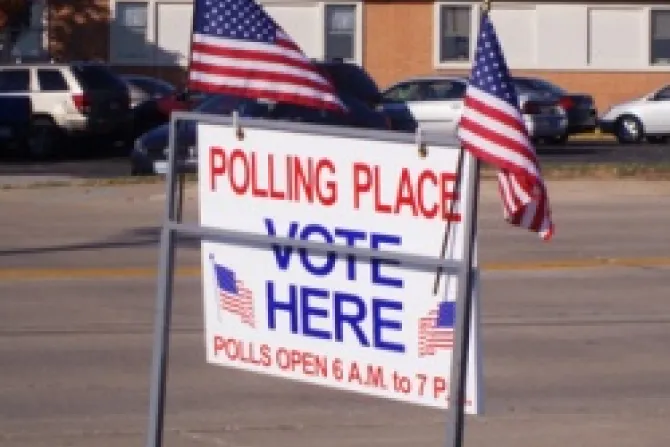Washington D.C., Sep 28, 2012 / 09:55 am
A recent poll showing President Barack Obama with a 15-point lead over Republican candidate Mitt Romney among Catholic voters may not represent the actual attitudes of the Catholic electorate, analysts say.
"Keep in mind that a survey is just that – it's a survey," said Dr. Matthew Green, a politics professor who deals with the field of U.S. elections at The Catholic University of America. "There's always some uncertainty."
A poll released by Pew Research Center on Sept. 16 showed Obama with 54-39 percent lead over Romney among self-identified Catholics.
While the survey, conducted Sept. 12-16, did show Romney with a nine point advantage among those who attend church services regularly, the poll results of the general Catholic population differed significantly from those shown by other surveys.
A Gallup poll released on the same day showed Obama leading by only five points, 49-44. That poll was based on a three-week rolling average from Aug 27 - Sept 16.
Gallup's later poll from Aug. 20 – Sept. 9 showed Obama leading by just two percentage points among self-identified Catholics, 47-45.
Analysts offered various explanations for the discrepancy with the Pew poll.
Green told CNA that a single poll is "not necessarily the most reliable measure," and it can be helpful to look at numerous polls.
While he could not comment on which poll was more accurate, he said that he was "a little hesitant to accept the Pew numbers."
He noted that the Pew survey was just a single poll that seems to be an "outlier," while Gallup has been doing weekly polls on the election for months, showing "general stability" with only "gradual changes."
In addition, he observed, Gallup averages its polls over a three-week period in order to average out irregularities that could be misleading.
While its results are not necessarily wrong, Green said that he "wouldn't put too much weight on the Pew data."
He explained that Pew surveyed only 540 people who self-identified as Catholic, while Gallup surveyed 2,100 people. Therefore, Pew's data for Catholics has a "much bigger margin of error," which indicates less certainty that the poll "reflects the true preferences of the population."
Geoff Skelley, media relations coordinator for the University of Virginia's Center for Politics, noted that "all polls have just slightly different methodology."
Websites that average numerous different polls can sometimes help in trying "to find a balance" and smooth out any irregularities in individual polls, he explained.
Georgetown's Center for Applied Research in the Apostolate has aggregated data from polls on Catholics conducted by Pew, Gallup and TIPP. The results indicated a close race over the last several months, in which neither candidate consistently garnered more than 50 percent of Catholic support.
(Story continues below)
The recent inconsistencies in poll results extended beyond merely the Catholic vote and into the general population as well.
Joe Garofoli of the San Francisco Chronicle observed that a Sept. 19 Pew Research poll showed Obama leading Romney by eight percentage points, while a Gallup survey taken over the same time period had them tied.
Discrepancies such as these, he said, can be attributed to the different wording of questions, differing methods of attempting to integrate cell phone users into polls and differences between polling "registered voters" and "likely voters."
In early August, Pew was critiqued for a survey showing Obama with a 10-point lead over Romney in a poll that included nearly twice as many self-identifying Democrats as Republicans.
Pew defended its poll in a statement asserting that standardizing the distribution of Democrats and Republicans "would unquestionably be the wrong thing to do."
The research center explained that "party identification is one of the aspects of public opinion that our surveys are trying to measure, not something that we know ahead of time like the share of adults who are African American, female, or who live in the South."
"(S)hifts in party identification are essential to understanding the dynamics of American politics," it said.
Some critics, however, said that such a significant inequality in party distribution could be making the polls less accurate.
Columnist Jim Geraghty complained in the National Review Online that Pew has made a "habit of including an unrealistic percentage of Democrats in their sample."
He argued that the organization has been inaccurate in polling before recent elections because its polling samples do not reflect the fact that "the electorate is going to be more than 24 percent Republican, and self-identified Democrats aren't going to outpace Republicans by 9 percentage points."
Commentator Dick Morris suggested that the polls being produced by many organizations are flawed because they are using the 2008 election as a model for weighting respondents.
However, it is unlikely that African Americans, Latinos and young adults will have the same unusually high voter turnout in this election that they did in 2008, he said, pointing to surveys indicting a lack of enthusiasm and novelty, as well as a sense of disappointment, among these groups.
As a result, he argued, many polls showing Obama with a drastic lead over Romney are actually "misleading."



